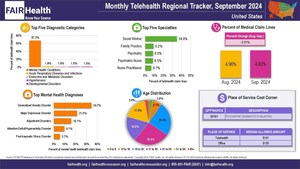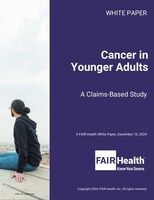Telehealth Claim Lines Increase 3,806 Percent Nationally from July 2019 to July 2020
In July, for First Time This Year, Substance Use Disorders among Top Five Telehealth Diagnoses in Northeast
Findings from FAIR Health's Monthly Telehealth Regional Tracker Suggest Continuing Impact of COVID-19 Pandemic
NEW YORK, Oct. 6, 2020 /PRNewswire/ -- Telehealth claim lines1 increased 3,806 percent nationally from July 2019 to July 2020, rising from 0.15 percent of medical claim lines in July 2019 to 6.00 percent in July 2020, according to new data from FAIR Health's Monthly Telehealth Regional Tracker. The data represent the privately insured population, excluding Medicare and Medicaid.
While increasing greatly from 2019 to 2020, telehealth claim lines fell 12 percent nationally on a month-to-month basis, from 6.85 percent of medical claim lines in June 2020 to 6.00 percent in July 2020.
Trends in the four US census regions (Midwest, Northeast, South and West) were similar to those in the nation as a whole. In each region, there were large percent increases in volume of claim lines from July 2019 to July 2020, but small drops in volume of claim lines from June 2020 to July 2020. The Northeast had the greatest percent increase in volume of any region from July 2019 to July 2020: 8,987 percent. From June to July 2020, it also had the greatest percent decrease: 16 percent.
Higher telehealth utilization from March to July 2020 in comparison with the same months in 2019 is likely a result of the COVID-19 pandemic. In March and April 2020, many states prohibited in-person rendering of elective procedures, making telehealth an attractive alternative. Many of these prohibitions expired in May as states began to open up, perhaps accounting for the decline in the telehealth share of total medical claim lines in May, June and July relative to April. However, that decline slowed from month to month, and telehealth usage remained high by comparison with 2019.
In another notable finding of the July Monthly Telehealth Regional Tracker, for the first time this year, substance use disorders emerged as one of the top five telehealth diagnoses, though only in the Northeast, where this diagnosis ranked fifth. This is consistent with an increase in substance use disorders that has been noted during the COVID-19 pandemic by the Centers for Disease Control and Prevention and others. It is also consistent with a trend toward use of telehealth to treat a wider variety of conditions.
In July, mental health conditions continued to be the number one telehealth diagnosis nationally and in every region, as they had been since March 2020. Nationally, mental health conditions represented 45 percent of telehealth claim lines in July 2020, compared to 37 percent in July 2019.
However, the percentage of telehealth claim lines accounted for by mental health conditions nationally in July 2020 stabilized, increasing monthly by one percentage point (from 44 percent in June to 45 percent in July) after larger increases in May and June. This stabilization may be the result of many people having already sought telehealth for mental health issues during the COVID-19 pandemic, leaving little room for the diagnosis to grow. It may also be due to the increasing number of other diagnoses being treated during the pandemic.
About the Monthly Telehealth Regional Tracker
Launched in May as a free service, the Monthly Telehealth Regional Tracker uses FAIR Health data to track how telehealth is evolving from month to month. An interactive map of the four US census regions allows the user to view an infographic on telehealth in a specific month in the nation as a whole or in individual regions. In addition to data on the volume of claim lines and on diagnoses, each infographic includes findings on urban versus rural usage and the top five telehealth procedure codes.
FAIR Health President Robin Gelburd stated: "The COVID-19 pandemic is continuing to have a pronounced impact on telehealth, but the details of that impact vary from month to month. FAIR Health's Monthly Telehealth Regional Tracker provides a window into how this venue of care is evolving."
For the Monthly Telehealth Regional Tracker, click here.
Follow us on Twitter @FAIRHealth
About FAIR Health
FAIR Health is a national, independent nonprofit organization that qualifies as a public charity under section 501(c)(3) of the tax code. It is dedicated to bringing transparency to healthcare costs and health insurance information through data products, consumer resources and health systems research support. FAIR Health possesses the nation's largest collection of private healthcare claims data, which includes over 32 billion claim records and is growing at a rate of over 2 billion claim records a year. FAIR Health licenses its privately billed data and data products—including benchmark modules, data visualizations, custom analytics and market indices—to commercial insurers and self-insurers, employers, providers, hospitals and healthcare systems, government agencies, researchers and others. Certified by the Centers for Medicare & Medicaid Services (CMS) as a national Qualified Entity, FAIR Health also receives data representing the experience of all individuals enrolled in traditional Medicare Parts A, B and D; FAIR Health includes among the private claims data in its database, data on Medicare Advantage enrollees. FAIR Health can produce insightful analytic reports and data products based on combined Medicare and commercial claims data for government, providers, payors and other authorized users. FAIR Health's systems for processing and storing protected health information have earned HITRUST CSF certification and achieved AICPA SOC 2 compliance by meeting the rigorous data security requirements of these standards. As a testament to the reliability and objectivity of FAIR Health data, the data have been incorporated in statutes and regulations around the country and designated as the official, neutral data source for a variety of state health programs, including workers' compensation and personal injury protection (PIP) programs. FAIR Health data serve as an official reference point in support of certain state balance billing laws that protect consumers against bills for surprise out-of-network and emergency services. FAIR Health also uses its database to power a free consumer website available in English and Spanish and an English/Spanish mobile app, which enable consumers to estimate and plan for their healthcare expenditures and offer a rich educational platform on health insurance. The website has been honored by the White House Summit on Smart Disclosure, the Agency for Healthcare Research and Quality (AHRQ), URAC, the eHealthcare Leadership Awards, appPicker, Employee Benefit News and Kiplinger's Personal Finance. FAIR Health also is named a top resource for patients in Dr. Marty Makary's book The Price We Pay: What Broke American Health Care—and How to Fix It and Elisabeth Rosenthal's book An American Sickness: How Healthcare Became Big Business and How You Can Take It Back. For more information on FAIR Health, visit fairhealth.org.
Contact:
Dean Sicoli
Chief Communications Officer
FAIR Health
646-664-1645
[email protected]
1A claim line is an individual service or procedure listed on an insurance claim.
SOURCE FAIR Health

Related Links
WANT YOUR COMPANY'S NEWS FEATURED ON PRNEWSWIRE.COM?
Newsrooms &
Influencers
Digital Media
Outlets
Journalists
Opted In






Share this article